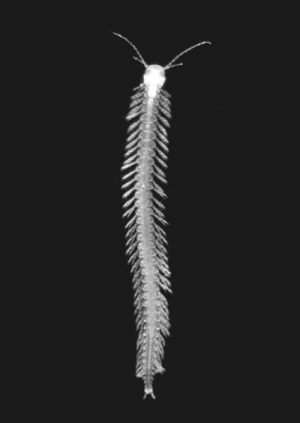October 23, 2013 report
First venomous crustacean discovered living in underwater caves

(Phys.org) —A research team with members from the U.K., Germany, and Mexico has confirmed the first known existence of a venomous crustacean. In their paper published in the journal Molecular Biology and Evolution, the researchers describe their study of Speleonectes tulumensis, of the group remipedes as well as their finding that it is indeed the first known crustacean to use venom to capture and kill prey.
Remipedes are a type of crustacean, which is a subgroup of arthropods. Venom is of course found in a wide variety of arthropods such as spiders and scorpions, but never before has a crustacean (of which there are 70,000 known kinds) been known to create and use venom.
Scientists have suspected S. tulumensis may be unique since they were first discovered living in underwater caves along coastlines in Mexico and Central America as far back as the 1980's. They have hollow fangs on the sides of their head behind their jaws. No one's been able to study them up close until now, however because of the difficulty in getting to where they live. In this latest effort, the team was able to collect some samples and then took them back to their lab. There they discovered that the one-of-a-kind creature actually has a complex venom delivery system, and that it produces more than one type of toxin.
Specifically, they found that the tiny creature has muscles that contract to pump venom into the fangs, and another set they use for injection once prey is bitten (they are also able to squeeze off the fang chamber to prevent backwash). They also found that the venom has a both a neurotoxin and enzyme in it to deal with prey in two different ways. The neurotoxins (similar to those found in spider venom) act to disable prey, likely by causing spasms, while the enzymes (similar to those found in snake venom) break down body tissue allowing S. tulumensis to suck the body out of the shell and then to digest it.
The researchers suggest that if one type of crustacean is venomous, it's likely there are others that just haven't been discovered yet. They also can offer no explanation as to why this particular creature out of all the others has developed the trait other than to note that it evolved in an environment that doesn't have many food sources.
More information: The first venomous crustacean revealed by transcriptomics and functional morphology: remipede venom glands express a unique toxin cocktail dominated by enzymes and a neurotoxin, Mol Biol Evol (2013) DOI: 10.1093/molbev/mst199
Abstract
Animal venoms have evolved many times. Venomous species are especially common in three of the four main groups of arthropods (Chelicerata, Myriapoda, Hexapoda), which together represent tens of thousands of species of venomous spiders, scorpions, centipedes and hymenopterans. Surprisingly, despite their great diversity of body plans there is no unambiguous evidence that any crustacean is venomous. We provide the first conclusive evidence that the aquatic, blind and cave-dwelling remipede crustaceans are venomous, and that venoms evolved in all four major arthropod groups. We produced a three-dimensional reconstruction of the venom delivery apparatus of the remipede Speleonectes tulumensis, showing that remipedes can inject venom in a controlled manner. A transcriptomic profile of its venom glands shows that they express a unique cocktail of transcripts coding for known venom toxins, including a diversity of enzymes and a probable paralytic neurotoxin very similar to one described from spider venom. We screened a transcriptomic library obtained from whole animals and identified a non-toxin paralogue of the remipede neurotoxin that is not expressed in the venom glands. This allowed us to reconstruct its probable evolutionary origin, and underlines the importance of incorporating data derived from non-venom gland tissue to elucidate the evolution of candidate venom proteins. This first glimpse into the venom of a crustacean and primitively aquatic arthropod reveals conspicuous differences from the venoms of other predatory arthropods such as centipedes, scorpions and spiders, and contributes valuable information for ultimately disentangling the many factors shaping the biology and evolution of venoms and venomous species.
Journal information: PLoS ONE , Molecular Biology and Evolution
© 2013 Phys.org



















